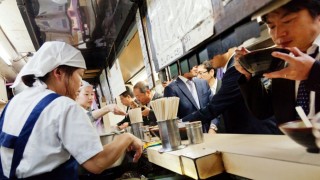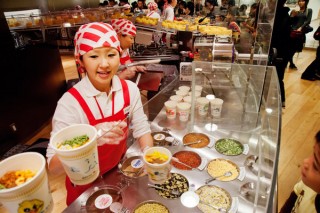Loading
Search
▼ Choosing Fast and Cheap Over High-End Chic in Yokohama, Japan
- Category:Other

NY TIMES
It was breakfast time in Yokohama Station, a half-hour by train from Tokyo, and I was having some of the best soba noodles of my life. The chewy buckwheat strands were sublime, the broth deeply savory and piping hot. A fresh-cracked egg floated on top, its yolk a gorgeous sunrise orange.
Kisoba Suzuichi, at the station’s west exit, had signage only in Japanese and makes just two things: soba and udon. I’d been wandering around, hazy from jet lag; the first time I passed by, I could smell the fragrant dashi broth from down the block, but it wasn’t yet open. A half-hour later, there was already a line, composed almost entirely of suit-clad salarymen on their way to work. Soon I was happily slurping. My meal cost 340 yen, $3, at 110 yen to the dollar.
Though Japan is known for being a nation of meticulously crafted sushi and a sky-high number of Michelin-starred restaurants (Yokohama included), “B-grade gourmet” — code for food that’s fast, cheap and good — is currently all the rage here, with a ton of passionate blogs devoted to the subject. There are even B-grade gourmet food festivals that celebrate different takes on tasty, down-home cooking. Yokohama, the second-largest city in Japan and its historic center of foreign trade, has a cross-cultural history that makes it a particularly rich entry point to sample the range of what B-grade gourmet can be. Recently, I spent a few days combing the city’s waterfront and neighborhood shopping streets, tailing locals on a mission to track down cheap, comforting meals for every hour of the day.
At Kisoba Suzuichi, the black-aproned women behind the curtained counter smiled and pointed out the noodle options, and asked if I wanted a vegetable tempura cake on top; I saw eggs on the shelf behind them and requested one, too. There were no tables or chairs, so I ate my noodles while seated on the curb, businessmen on either side of me. All of us bent over our bowls, heads down, as if penitent before the street-food stand. It was just the right kind of belly-warming meal to reset my body’s clock.
Just southeast of the train station, Yokohama has an expansive waterfront with a central business district, Minato Mirai, which means “Port of the Future.” It’s a great place to get some walking in, particularly during special events like the Yokohama Triennale art fair (the 2014 edition just wrapped up earlier this month). In recent years, Minato Mirai has been developed with high-end hotels, office towers, shopping malls and a fascinating array of museums. One of these is the CupNoodles Museum, a surprisingly sophisticated tribute to one of the world’s simplest dishes — instant ramen — and a whirlwind survey of noodle cuisines from around the world (admission, 500 yen; children free).

Five floors of interactive exhibits tell the tale of Momofuku Ando, who, in 1958, after a year of backyard-shed tinkering, invented a just-add-hot-water chicken ramen that became a sensation in postwar Japan. In 1971, after a research trip to the United States to observe how Americans ate, he went on to perfect the concept further, with Cup Noodles: an instant ramen that could be cooked and eaten in its container. Some exhibits at the museum glorify Ando to a ludicrous extent — one tableau places him alongside Einstein and Beethoven. Then again, my mother still talks about surviving on the cheap noodle packs as a teenager in Hong Kong during the early 1960s. (As penny-pinching college students, my roommates and I regularly smuggled Cup Noodles into ski resort cafeterias all over Vermont and Maine, but that’s a less dramatic tale.)
The best part of the museum? For 300 yen, you can make your own customized Cup Noodles to take with you. First, you decorate the distinctive red and white Styrofoam containers at art stations outfitted with special markers; next, you choose your broth (seafood, curry, original flavor) and toppings (oddball options include dried cheese chunks and tiny Tweety Bird wafers). Finally, you can observe the entire shrink-wrapping process through a series of giant factory windows and insert your made-to-order creation in an inflatable bag to wear around your neck (don’t ask).
You can also make ramen by hand in the adjacent Chicken Ramen Factory, but it costs another 500 yen and requires reservations for at least two people. Instead, I paid a visit to the noodle bazaar on the factory’s top floor, which approximates a pan-Asian night market: numerous booths dish out snack-size helpings of Kazakh lagman, Lanzhou beef ramen, Thai tom yum goong noodles and Malaysian laksa (as well as Italian spaghetti), each for 300 yen. My favorite was the Vietnamese pho, the rice noodles served in a bowl of simple, clear broth and brightened with lemon grass and chiles.
This international taste tour is fitting for Yokohama, whose districts with significant foreign influences and history — like the hills above the Motomachi neighborhood, south of the harbor, where the British and French set up their diplomatic missions and ornamental gardens — still host expatriate populations today. Motomachi shares a subway stop with Japan’s largest Chinatown, Chukagai, a wildly popular tourist attraction among the Japanese, with inflated prices to match.
As with other Chinatowns, though, if you wend your way from the main avenues, you’ll find great little alleys to explore; here, they are lined with street stalls selling coconut-dusted mochi balls for 100 yen, 300-yen Kirin beer and multidish meal deals catering to corporate types heading home. (“Follow the salarymen” was becoming a useful rule of thumb, I found.) I even spotted one stand selling bowls of shark fin soup for 200 yen, though the rock-bottom price was reason enough to be deeply skeptical of the provenance of its normally pricey (and controversial) main ingredient.
Arrive around lunchtime or at 5 p.m., and Chukagai is especially alive with pedestrians and entertainment. For 1,000 yen, there are stands where elderly women will read your palm and tell your fortune. I opted to spend my yen allotment on a few small and charming gifts, of which there are many inexpensive choices: a panda-face steamed bun, a pretty candy tin printed with a picture of Mount Fuji, a fish-patterned pair of socks — each for 500 yen or less.
From Chinatown, you can catch a five-minute cab ride to Honmoku Dori, an affordable shopping street on the other side of Motomachi that’s frequented by local residents. A B-grade gourmet enthusiast could go wild with Honmoku’s density of restaurants, which include home-style tempura and yakitori joints and Chinese and Italian cuisine. I ate delicious sashimi from Inase, a tiny sushi bar with bento lunch box specials for as little as 400 yen.
The area is also chockablock with little stores selling senbei (rice crackers), tea and red bean mochi sweets; I bought a gift bag of Shizuoka green tea for 500 yen. And there are plenty of bakeries, a special pride of the Japanese. Shirasu, baby sardines, are a regional specialty of nearby Kamakura, a seaside town a half-hour southwest of Yokohama; I tried the delicacy on a small pizza pastry, with wasabi, scallions and cheese (280 yen). It had a pleasing marine brininess and a slightly crunchy texture.
About a 10-minute walk west of the Motomachi-Chukagai train station, I found one of my favorite B-grade gourmet places: the atmospheric pub Hazuki, a good example of an anaba, or hole in the wall. The wood-paneled décor and vintage beer posters are reminiscent of 1950s drinking establishments on military-occupied Okinawa. Late one Thursday evening, my friends and I got a back booth, removed our shoes per local custom and proceeded to sample the extensive menu of traditional Okinawan bar food.
There was umi budou, or sea grapes, a kind of pearly seaweed; jimami tofu, a rich, creamy tofu made with peanuts; and rafute, a marinated, slow-cooked pork belly (600 to 700 yen a plate; our meal came to about 1,800 yen per person). The emerald clusters of sea grapes popped like bubbles in my mouth — Okinawans call it “green caviar” — and I was impressed by the generous cuts of tender pork belly. The big glass mugs of beer were cheap, as were the cocktails made with awamori, a distilled spirit native to Okinawa (drinks start at 500 yen).
The cheapest place to drink in Yokohama is probably on the Kirin Brewery factory tour — both the booze and the tour are free. But I’d argue that the cultural value and unique atmosphere that come with visiting a local B-grade anaba are well worth the extra few yen.
- November 20, 2014
- Comment (0)
- Trackback(0)

